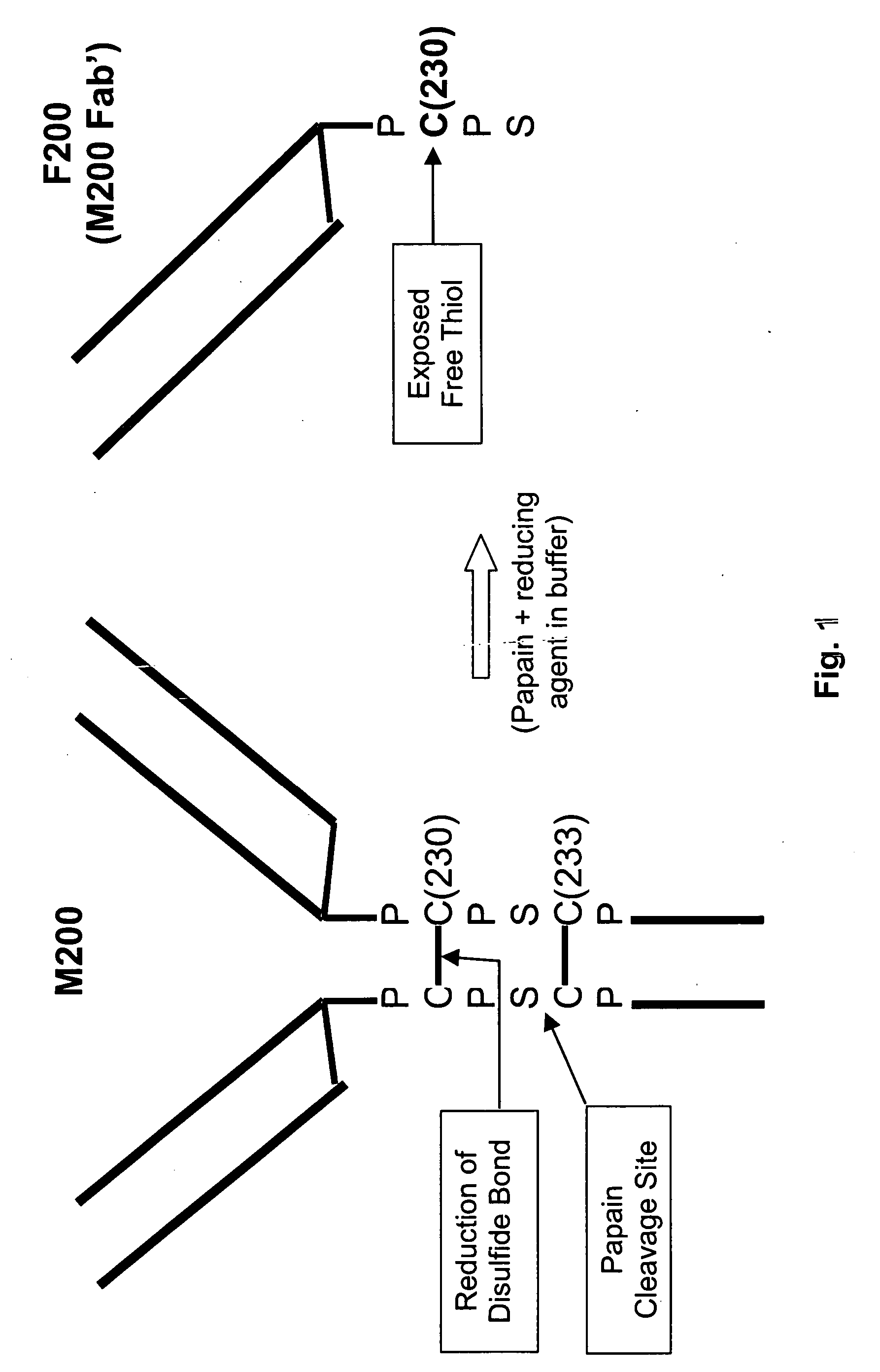Stable liquid and lyophilized formulation of proteins
a technology of protein and liquid, which is applied in the field of immunology and pharmaceutical formulations, can solve the problems of fab′-sh fragments that are typically not stable in liquid formulations, prone to oxidation and aggregation, and microvascular thrombosis in tumor capillaries
- Summary
- Abstract
- Description
- Claims
- Application Information
AI Technical Summary
Problems solved by technology
Method used
Image
Examples
example 1
Generation of Fab′SH Antibody Fragments by Papain Digestion.
[0142] A chimeric anti-α5β1 integrin antibody, M200, (described in the U.S. patent application with Publication No.: US 2005 / 0054834 A1, filed Nov. 26, 2003, which is incorporated herein by reference in its entirety), or humanized anti-VEGF IgG4 antibody (HuMV833-PDL) (both IgG4 antibodies) were buffer exchanged into 20 mM sodium phosphate and 20 mM N-acetyl-L-cysteine at a pH of 7.0. Soluble papain enzyme in an enzyme / antibody ratio of 1:10000 was added. The mixture was rotated at 37° C. for 3 hours. After digestion, the mixture was purified to remove Fc fragments and undigested IgG leaving a purified Fab′-SH antibody fragment. Liquid Chromatography Mass Spectrometry (LC-MS) analysis revealed that the main cleavage sites of HuMV833 and M200 are identical. The main cleavage site for HuMV833 is between S226 and C227. The corresponding cleavage site for M200 is between S232 and C233, which when cleaved gives rise to a Fab′-S...
example 2
Production of Stable Fab′ Derivatives of M200
[0143] Fab′ derivatives were produced by three major steps, including digestion, chemical treatment after digestion, and formulation. Various conditions were tested for each step to develop the optimal ways of making the stable formulation of the derivatives, including the type of reducing agents, the type of treatment after digestion, and the type of formulation. Three separate matrices containing different combinations of experimental conditions were designed and the experiments carried out as described below. Table 1 summarizes the conditions and results of Matrix #3, which was representative of two other experimental matrices.
[0144] The general experimental procedure was as follows: the antibody M200 [SEQ ID NOS: 1 and 2] was buffer exchanged into 20 mM sodium phosphate at pH 7.0; soluble papain enzyme was added in an enzyme / antibody ratio of 1:10000; a reducing agent was added into the reaction mixture at a selected concentration (...
example 3
Stability Studies of Formulations Comprising F200Fab′NAC
[0147] F200Fab′NAC molecules prepared as described above were stored at a concentration of 20 mg / ml in a formulation comprising 40 mM sodium citrate, 90 mM sodium chloride, 0.05% Tween 80 at pH 6.0.
[0148] Size Exclusion Chromatography (SEC) was used to examine the stability of F200Fab′NAC at 5° C., 25° C., and 37° C., for up to three months in the formulation. Data corresponding to the percentage of F200Fab′NAC dimer, and percentage of clip formation was measured over a period of 12 weeks (at time points 0, 1, 2, 4, 8 and 12 weeks) and at 5° C., 25° C., and 37° C. respectively.
[0149] Over a 12-week period, minimal changes were observed in the percentage dimer levels of the samples stored at 5° C. (i.e. less than 1% dimer observed). The samples at 25° C. and 37° C. had percentage dimer levels of 2.57% and 7.23%, respectively at 12 weeks. The percentage of F200Fab′NAC monomer measured indicated more than 98% in the formulation...
PUM
| Property | Measurement | Unit |
|---|---|---|
| Fraction | aaaaa | aaaaa |
| Fraction | aaaaa | aaaaa |
| Fraction | aaaaa | aaaaa |
Abstract
Description
Claims
Application Information
 Login to View More
Login to View More - R&D
- Intellectual Property
- Life Sciences
- Materials
- Tech Scout
- Unparalleled Data Quality
- Higher Quality Content
- 60% Fewer Hallucinations
Browse by: Latest US Patents, China's latest patents, Technical Efficacy Thesaurus, Application Domain, Technology Topic, Popular Technical Reports.
© 2025 PatSnap. All rights reserved.Legal|Privacy policy|Modern Slavery Act Transparency Statement|Sitemap|About US| Contact US: help@patsnap.com

